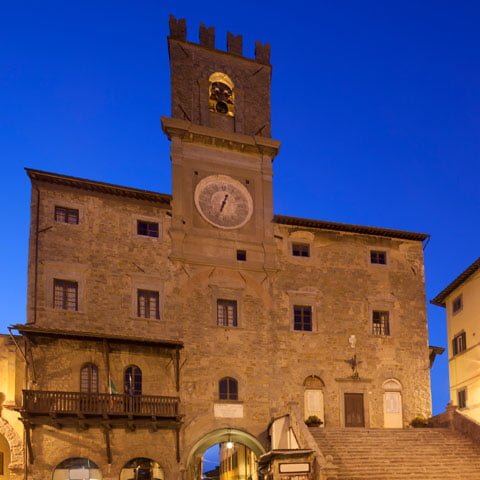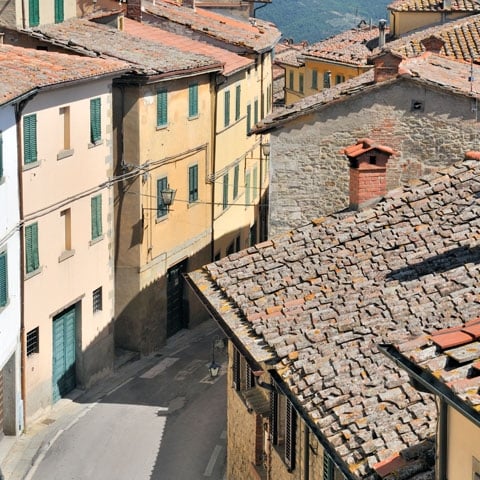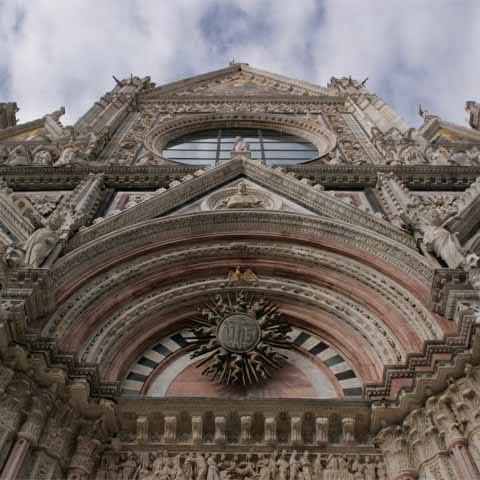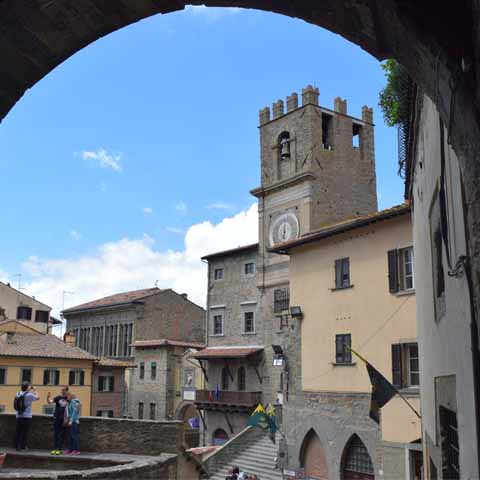Cortona is a small Tuscan town rich in history and steeped in artistic and cultural testimonies. Located in the province of Arezzo, Cortona serves a hub for the picturesque Val di Chiana area. As a hilltop town filled with historic architecture and surrounded by the tranquil Tuscan countryside, there is beauty everywhere one looks in Cortona.
In 2003, the American film Under the Tuscan Sun, cemented Cortona’s reputation as the quintessential Tuscan town where life is savored, spectacular panoramas are endless, and food is simply divine. Despite its modest size, today Cortona is a preferred travel destination among travelers from all over the world.
PREHISTORY OF CORTONA
According to legend, the hero Dardano left Cortona to establish the city of Troy. Beyond the myths, historical information was passed down through ancient writings; Herodotus and Dionysius of Alicarnassus both wrote of Cortona attributing its founding to the Umbrian population.
During the eighth and seventh centuries BC, Cortona was conquered by the Etruscans who controlled the whole territory of the Chiana Valley.
The current name of the town seems to derive from Curtun, which was the name of the ancient Etruscan city. Cortona was one of the rich cities of the Etruscan dodecapolis that were governed by the principes, administrators belonging to the aristocratic families. Names of princes and magistrates are visible on the numerous archaeological artifacts uncovered in the area.
At the end of the fourth century BC, Cortona became a Roman municipium with considerable autonomy and part of the “Stellatina Tribe.” The defensive walls date back to the Roman period, as do many of its palaces.
HISTORY OF CORTONA
Cortona saw the occupation of the barbarian between the fifth and eighth centuries AD.
Between 1000 and 1100 AD, there were numerous conflicts with Perugia. Given its strategic position, the territory of Cortona was coveted by both the Municipality of Arezzo and Florence. Between 1258 and 1261, the city was occupied by the Guelphs from Arezzo. Siena came to the aid of Ghibelline Cortona and in April 1261 the invaders were driven out.
In 1325, the period of the free municipality ended. The period initially arose with the opening of rural universities in 1219 and then established itself with a decisive prevalence of the urban classes, which after 1250 had excluded the representatives of the countryside from the councils. Numerous religious orders founded convents and churches in Cortona at this time, which favored cultural liveliness and urban expansion.
The statute of 1325 shows how the city had its own territory, mint, autonomous laws, and a real Lordship, governed by the Casali family.
Until the early 1400s, Cortona was ruled by representatives of the local aristocracy and experienced a period of relative peace, except for the internal discords of the aristocratic families in power.
After the occupation of Ladislaus, King of Naples, in 1409, Florence took over Cortona in 1411. The entry of Cortona into the sphere of influence of Florence led to the end of independence. The city’s aristocracy found alliances with the Florentine one.
Cultural development continued for the city. In 1556, the Grand Duke Cosimo modified the defensive walls and fortresses, giving the town the urban plan still visible today. During this period, the squares and many medieval dwellings were demolished, while palaces similar to the Florentine ones as well as churches and abbeys were built. There were massive reclamations in the Cortona countryside with the improvement of civic infrastructure.
In 1737, with the death of Gian Gastone de’ Medici, Cortona was annexed to the Grand Duchy of Tuscany. Subsequently, the Habsburg-Lorraine took over as Grand Dukes of Tuscany.
Various cultural academies were established, including the Etruscan Academy, a research center that makes Cortona famous in intellectual circles all over Europe.
In 1799, Napoleon’s troops attempted to occupy the town, but were not successful.
During the nineteenth century, Cortona actively participated in the Risorgimento uprisings that ended with the plebiscite of 1860, when Cortona was annexed to united Italy.
At the end of the 1800s, there were over 800 priests, friars, and nuns in Cortona. Countless convents and churches, with different architectural styles ranging from Romanesque to Renaissance, are still visible today.
During the twentieth century Cortona took part in the two World Wars. In 1944, Cortona was the scene of fierce German reprisals and massacres. Cortona, however, was not hit by bombing, so its historic buildings remain visible today.
ARCHAEOLOGY IN CORTONA
The MAEC: Etruscan Academy and Cortona City Museum is housed in Palazzo Casali, one of the oldest and most historic buildings in town, where some of the most extraordinary masterpieces of the Etruscan civilization are exhibited over 21,000 square feet.
The museum traces the history of Etruscology starting from the eighteenth century and the local rediscovery of Etruria. Among the objects on display are the extraordinary Etruscan chandelier, the collection of bronzes, the small but important Egyptian section, the picture collections, and the splendid eighteenth-century library.
The museum also grants access to the Archaeological Park of Cortona with 11 sites located in the historic center and the surrounding area. Of particular interest are the Tumuli of Sodo, the Tanella Angori, and the Tanella di Pitagora.
The Tumuli of Sodo has a spectacular staircase-terrace decorated with sculptural groups and architectural Eastern-style elements. The Tanella Angori tomb dates back to the second century BC and has a diameter of over 32 feet with the interior in the form of a Greek cross. The Tanella di Pitagora is located on the slope that descends from the hill of Cortona towards the Val di Chiana. It is a small tumulus from the second century BC consisting of a circular base on which another drum with juxtaposed blocks is set. The interior has a short dromos and a small rectangular room covered by a barrel vault.
Don't just see Italy, live it.
Your dream trip to Italy has never been closer
No more endlessly scrolling travel sites. Our travel experts will craft the perfect, one-of-a-kind trip just for you.

300+
DESTINATIONS
We offer more Italian destinations than any travel site. Do and see more with Trips 2 Italy.
1 (of a kind)
ITINERARIES
Because your dream trip to Italy should be designed for you, not for the masses.
100%
PEACE OF MIND
From flights and accommodations, to food and activities - we take care of every detail.
















